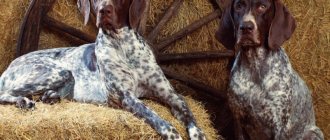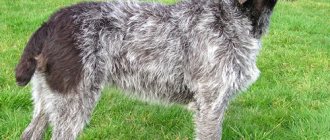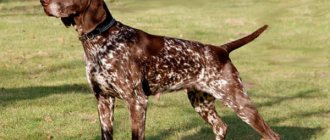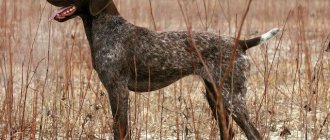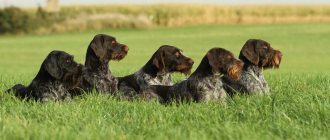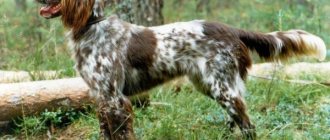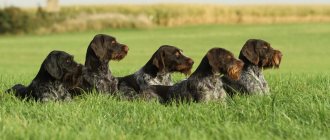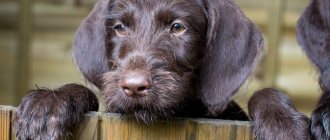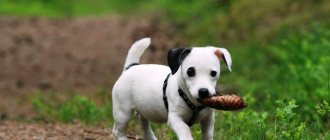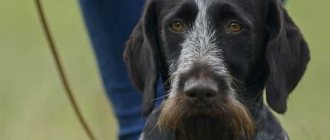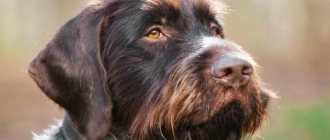When you think about a dog, in addition to its character traits and the goals of the establishment, you undoubtedly think about what the future pet should look like.
The variety of breeds is so great that based on the desired traits, you can choose the ideal potential dog breed that will meet all your needs and dreams. Large and small, pocket and guard, fur-haired and wire-haired dog breeds - canine selection provides a huge selection of many options.
And if you don’t like fluffy clouds on legs, but want something more charismatic and daring, then we present you a list of wire-haired dog breeds from tiny companions to full-sized dogs.
Breed traits
Breed traits (on a 5-point scale)
| German Drahthaar (German Wirehaired Pointer) | |||
| Activity | in the house | 2 | |
| on the street | 3.9 | ||
| Obedience | training | 4.5 | |
| strangers | 2 | ||
| Domination | in family | 2 | |
| over dogs | 3 | ||
| Defending your territory | from people | 2 | |
| from dogs | 2 | ||
| Sociability | in family | 4 | |
| with strangers | 1.2 | ||
| with dogs | 1.3 | ||
| Concentration | in family | 1 | |
| in front of strangers | 3 | ||
| with dogs | 2 | ||
| Aggressiveness | in family | 1 | |
| to strangers | 1 | ||
| to the dogs | 2 | ||
| to cats | 2 | ||
| Family behavior | calmness | 4 | |
| demand for affection | 3.5 | ||
| excitability | 3 | ||
| playfulness | 2.8 | ||
| excessive barking | 1 | ||
| behavioral breakdowns | 2 | ||
| Tolerance for children | up to 4 years | 4 | |
| over 4 years old | 4 | ||
| Institutional use | watchman | 4.7 | |
| bodyguard | 4 | ||
This breed is often compared to the following dog breeds: German Shorthaired Pointer (German Shorthaired Pointer), German Shepherd, Wirehaired Griffon Pointer (Griffon Corthals), Labrador Retriever, English Pointer.
The photo shows what the drathaar looks like:
Photo of a German Drahthaar
German drathaar
German Wirehaired Pointer
Drathaar
Teddy Roosevelt Terrier
The dogs were originally considered a subgroup of rat terriers. In 1999, the United Kennel Club of the United States recognized it as an independent breed. These are muscular, short dogs with a height of 20–38 cm. The coat is single-layered, semi-hard. The breed was named after the President of the United States, although he did not participate in the breeding of the breed. The politician kept similar dogs and spoke approvingly of them.
Teddy Roosevelt Terriers are obedient, quickly trained dogs with developed instincts of hunter, guard and watchman. They easily adapt to the lifestyle, temperament of the owner and family, but require regular physical activity.
General characteristics of the German Drahthaar breed
Drathaars belong to large breeds of dogs; the height of a male can reach 68 cm. He has a recognizable appearance, which seems funny because of his goatee and mustache. But this dog is serious and smart, and needs constant exercise and exercise. The Drathaar will never become an indoor pet; it requires an experienced owner and long walks.
With proper upbringing, this is a devoted and sensitive four-legged friend. He loves children and does not tolerate separation from his owner. Thanks to its high intelligence and good memory, it is easy to train. This dog can make a good watchdog. Although she has absolutely no aggression towards humans, she has an instinct to protect her territory.
Sometimes wire-haired cops are used to work in the Ministry of Emergency Situations and the police. Thanks to their sensitive sense of smell, they easily find drugs, explosives and other illegal substances. Their high performance, endurance and sensitivity make them good rescuers. But first of all, the Drathaar is a hunting breed.
| Options | Characteristic |
| breed name | Drahthaar or German Wirehaired Pointer |
| country of origin | Germany |
| time of birth of the breed | 19th century |
| group of breeds according to the ICF classification | cops |
| working qualities | universal hunter, can be a watchman, shepherd, companion |
| character traits | smart, loyal, friendly, sociable, obedient, fearless, hardy |
| life expectancy | 14-16 years old |
| height | males 61-68 cm, females 57-64 cm |
| weight | 23-32 kg |
| aggressiveness | low |
| activity | hyperactive |
| intelligence | very smart, easy to train |
| attitude towards a person | chooses one owner, cannot stand loneliness, is friendly with family members, is wary of strangers |
| health | strong |
| care | easy, doesn't shed much |
| content | not suitable for a city apartment |
| who are they suitable for? | experienced owners, active people |
A little about hunting with a drathaar
Representatives of the Drahthaar breed are hunting dogs. German pointers, pointers, hounds, setters, and Airedale terriers were used in their breeding. Selection was carried out in Germany, at the same time another similar breed appeared - the shorthaired pointer. But the drathaar was better suited for hunting in unfavorable conditions. Thanks to its wire-like wool, it is not afraid of frost, rain, sharp branches, and insects.
Drathaars have the best hunting qualities: passion, efficiency, endurance, sensitive sense of smell, high intelligence. They can crawl into impenetrable thickets, swamps, and dive into water. This universal assistant is used for hunting game birds, hare, fox and even wild boar or elk. It can easily find prey or a wounded animal by smell and notify its owner with a loud bark.
The most popular hunting with a drathaar is for birds: quails, partridges, pheasants, snipe, and ducks. This dog easily performs the following duties:
- tracks game;
- stands up to notify the owner about this;
- distracts prey by barking;
- leads the hunter to a wounded large animal;
- takes out and brings back a shot bird or hare.
These dogs have genetically inherent hunting qualities, so they track down game even without special training. If hunters get a drathaar, it is better to train it to hunt certain game. It is not recommended to use them as a baiting dog for hunting large animals.
Similar to this breed, the shorthaired pointer is also a hunting dog. But drathaars are more resilient, purposeful, and active. The shorthaired pointer is a smooth-haired pointer, which has recently almost lost its hunting qualities.
Photos complement the description of the Drahthaar breed:
Drathaar on the hunt
Game hunting
Hunting with a drathaar
Hunter and prey
pros
Drahthaar dogs have many advantages:
- high intelligence, easy to train, obedient and well-managed;
- developed hunting and guard qualities;
- friendly, love children;
- unpretentious, can live in an open-air cage in winter;
- hard wool protects from cold, moisture, insects;
- not picky about food;
- faithful, devoted;
- hardy, efficient, strong, fearless.
Minuses
The Drathaar is a hunting dog; not everyone can handle its maintenance. Due to its tendency to dominate, it is not suitable for inexperienced dog owners. These dogs have a few more disadvantages:
- not suitable for apartment living;
- need serious physical activity;
- do not get along well with other dogs;
- can be stubborn, jealous and persistent;
- love to dig;
- cats and birds can be hunted on the street;
- They are suspicious of strangers and, if socialized incorrectly, can even show aggression.
Video about the advantages and disadvantages of drathaar:
Video: Dog breed Drathaar
Video: Drathaar - a universal pointer
Jack Russell Terrier
The founder of the breed is the English clergyman and breeder John Russell. He tried to breed small, fast hunting dogs that are able to pursue prey no worse than hounds and at the same time know how to climb into narrow holes, driving out small game. The breed became famous after the release of the comedy “The Mask” with Jim Carrey. There, the Jack Russell played the role of the curious jumping dog Milo.
The result of D. Russell's selection are hardy, flexible, fast dogs up to 30 cm in height. Ears drooping forward protect the shell from dust and dirt. There are 3 types of coat in the breed: smooth, hard and broken. Color is white with red, black or chestnut markings. Read about terriers up to 30 cm in height in the review of small terrier breeds.
History of the origin of the German Drahthaar breed
The Drathaar is a breed that originated in Germany in the 19th century. Researchers believe that wire-haired pointers have long existed in this country, which were used to hunt birds or hare. In the 19th century, breeding work began, the goal of which was to obtain a hunter with ideal working qualities. Other hunting breeds were used for breeding.
At the end of the 19th century, the first drathaars were presented at exhibitions. They were immediately recognized as the best hunting dogs. The German Wirehaired Pointer Drathaar was named due to the characteristics of its coat. The name translates as “hair like wire.” In 1924, the breed was officially recognized, and the first standard was adopted at the same time. German drathaars became popular in other European countries. But by the end of World War II, their numbers were greatly reduced.
In the middle of the 20th century, breeding of these dogs began to be carried out not only in Germany and other European countries. Drathaars came to the USA, where they did not immediately gain popularity. When breeding, special attention was paid to hunting qualities and endurance. Now the drathaar is the most popular pointer in the whole world. In addition to hunting, representatives of the breed are sometimes used in the search and rescue service and for police work. The drathaar can also be a good companion or watchman.
Classifications by country
In addition to the international classification of dog breeds, there are several national ones. The most well-known include the division from AKC, ACC and RKF.
American Kennel Club (AKC)
The AKC divides all its approved breeds into 8 groups:
- sports (Weimaraner, Cocker Spaniel, Gordon Setter, Pointer, Vizsla);
- hunting (beagle, pharaoh hound, Afghan hound, basenji, otterhound);
- workers (Akita, Commander, St. Bernard, Samoyed, Rottweiler);
- terriers (Scottish terrier, Welsh terrier, Cairn terrier, Border terrier, Australian terrier);
- indoor and decorative (pug, shih tzu, papillon, Yorkshire terrier, Pomeranian spitz);
- non-sports (Bichon Frize, Dalmatian, French Bulldog, Tibetan Terrier, Schipperke);
- herding dogs (collie, German shepherd, Australian cattle dog, sheltie, bobtail);
- others (Shiba Inu, Border Collie, Australian Shepherd, Cavalier King Charles Spaniel, Canaan Dog).
Many breeds are recognized by both the FCI and other organizations.
English Kennel Club (AKK)
There are even fewer groups in ACC than in AKS. According to their classification, a recognized breed can be classified into one of the following groups:
- gundogs (English Setter, Gordon Setter, Pointer, Retriever, Weimaraner);
- hunting (Basenji, dachshund, greyhound, Finnish spitz, Irish wolfhound);
- herding dogs (collie, German shepherd, Komondor, Samoyed, corgi);
- terriers (Airedale terrier, bull terrier, fox terrier, Scotch terrier, Welsh terrier);
- indoor and decorative (Bichon Frize, lapdog, Chihuahua, Italian Greyhound, Brussels Griffon);
- custom (Akita, bulldog, chow-chow, Dalmatian, poodle);
- workers (Alaskan Malamute, Boxer, Doberman, Siberian Husky, Mastiff).
It was with the English Kennel Club that the history of modern dog breeding began.
Russian Cynological Federation (RKF)
This classification is identical to the FCI, since the RKF is its member. The only difference is the inclusion of national breeds that are not recognized.
Appearance of the German Drahthaar breed
Drathaars are quite large dogs. Although, due to their “dry” thin constitution, they are classified as medium-sized breeds. Despite the fact that the height of the drathaar can reach 68 cm, the weight of an adult does not exceed 32 kg.
This dog has an unusual and memorable appearance. In addition to its large size and features of wool that look like wire, the adult drathaar is characterized by a broad-faced muzzle with a drooping mustache and goatee, as well as an attentive, intelligent look. They give them a strict, serious look, and even age them a little.
The photo shows the appearance features of the drathaar:
Drathaar head
Appearance of the drathaar
German drathaar
Drathhaar Muzzle
Head
The skull is wide, large, slightly convex, almost square in shape. The brow ridges are well defined, as is the transition from the forehead to the muzzle. The back of the head is flat, the muzzle is long and wide. The lips are black, close fitting, and the jaws are strong. The teeth are large, scissor bite. The nose is wide, black, but can be colored to match the color of the coat.
The eyes are medium in size, set wide apart. The eyelids fit tightly, the eye color is brown. The look is attentive and serious. The ears are small and drooping. Wide at the base, tapering downwards, rounded. Placed above the eye line.
Frame
The physique is harmonious and strong. The body is almost square in format, the length slightly exceeds the height at the withers. The neck is muscular, with a pronounced scruff, and there is no dewlap. The back is sloping, the loin is short, the croup is wide.
The chest is deep, voluminous, the stomach is tucked. The tail is not thick, it continues the top line. Holds horizontally or rises slightly. It is usually stopped in those countries where this procedure is not prohibited.
Limbs
The limbs are straight, set parallel. The elbows are pressed to the chest, located in the middle. The shoulder blades are muscular and directed backwards. The shoulders are long, the pasterns are set obliquely.
The thighs are muscular and long. The hock joints are well defined. The paw pads are hard, oval, the toes are gathered into a ball.
The dog runs sweepingly, smoothly. The limbs move in parallel, beautiful posture is maintained. Drathaars can run very fast, over long distances, and swim well.
Coat and color of drathaars
The coat is hard, lies close to the body, and is slightly wavy. It is short - 2-4 cm long, shorter on the head and stomach. The guard hair resembles a wire, the undercoat is very thick and does not get wet. Protects from cold in winter, from rain, and injuries. The fur forms characteristic eyebrows, mustaches and beards on the muzzle.
Speckled color is allowed as standard. Brown or black colors should also be present, as well as gray or silver. Large blurry spots on the sides or finely speckled color, steel gray, gray, coffee with gray are acceptable.
Sometimes there are pure brown individuals, which is also allowed by the standard. These dogs have a white “tie” on their chest. But this color is not recognized by UK breeders.
Photos complement the description of appearance:
Disqualifying faults
The drathaar standard clearly defines the features of appearance. Even small deviations can cause the dog to be disqualified; it is not allowed for exhibitions or breeding. The most common defects are:
- malocclusion;
- pointed or short muzzle;
- sparse or soft wool;
- wrong color;
- loose undercoat;
- drooping eyelids;
- different eye colors;
- uneven back line;
- mincing gait.
A drathaar can also be disqualified for its cowardly or aggressive character. This is still a hunting dog, so some qualities come first. This is a sensitive sense of smell, obedience, lack of fear of a shot and aggression, and efficiency.
The nature of dog allergies
It should be understood that there are no dogs in nature that do not cause allergies at all. It is customary to call hypoallergenic those pets in which shedding and the release of a special dog odor are less pronounced than in all other breeds. After all, not only wool is an allergen, it is the particles of saliva and skin found on it that are the main irritating factors that cause lacrimation, nasal congestion, sneezing and coughing attacks.
In addition, people's mucous membranes can react to dog dander, dry industrial feeding mixtures, and special pet care products.
A hypoallergenic dog in this case is one that a person does not experience any unpleasant consequences when being near it. But such dogs are nevertheless, to a certain extent, a source of allergens.
Moreover, this is so individual that a patient may have a completely different reaction to two dogs of a similar breed and identically kept. At the same time, two people with allergic reactions can pet the same pet with a completely opposite reaction - one begins to choke, and the other does not feel anything.
This is explained by the fact that each dog has an individual set of allergic markers, and people have different forms of irritation. Today there are clinics that can accurately map an allergy sufferer and indicate all the allergens that are dangerous for a given individual. Then it will be easier to choose your favorite for many years to come.
Nevertheless, there is still a certain logic when choosing in this case dogs of those breeds that do not shed and do not smell. But you should understand that the size of the future pet and the length of its fur do not matter here, but the increased secretion of saliva (salivation) is very important. Dogs belonging to breeds with well-developed jowls (boxers, bulldogs, pugs) should not be chosen by people with allergies.
The situation can be further aggravated by the dog’s bad character and bad manners. After all, the more often a dog barks, the more saliva erupts from its mouth.
The frequency of coat changes and the characteristics of its care are also of paramount importance. After all, the less hair shedding and the easier it is to comb out, the lower the allergenic factor.
Characteristics of the German Drahthaar breed
The German Drahthaar is a loyal friend and obedient companion. He chooses one owner for himself, although he is friendly towards all family members. This dog has absolutely no aggression towards humans. She can be used as a watchman; she is wary of strangers, but will never rush or bite.
Drathaar is ready to constantly accompany the owner and participate in all his affairs. He especially loves to run and play, so the breed is ideal for athletes, outdoor enthusiasts, and, of course, hunters. These pets love children, never offend, and willingly take part in all games.
Representatives of this breed are prone to dominance and jealousy, so they often come into conflict with other dogs. They may start hunting small animals and birds on the street. But if other pets live in the house with the drathaar, he communicates with them normally, even protects them.
This cop is characterized by the following character traits:
- friendliness;
- high intelligence;
- responsibility;
- determination;
- diligence;
- curiosity;
- devotion;
- sensitivity.
Training and education of the drathaar
This dog tends to be dominant, especially the male. Therefore, the owner must be able to gain authority from the pet. It is not difficult to train drathaars; they are smart, intelligent, and easily learn any commands. They sense the owner’s mood and understand what he wants. But not everyone can cope with them. This dog can be stubborn and independent. If the owner cannot show firmness, he will seek the fulfillment of his desires in different ways.
You need to start raising a German cop from the first days of his appearance in the house. It is important to socialize an already small puppy right away. You need to get used to loud noises, strangers, and other dogs. If the owner will use the pet for hunting, it is necessary to undergo a special training course. For a companion dog, socialization and learning the rules of behavior are enough.
The dog must obey unquestioningly, understand the commands “come”, “no”, “place”, “sit”, “fu”, “stand”. Drathaars are good at fetching and love games with searching for objects, outdoor games, and jogging.
During training, you need to be patient and strict, but you cannot shout, much less hit. These dogs do not tolerate rudeness and disrespect. For training to be effective, classes must be interesting and varied. For a puppy, it is better to conduct them in the form of a game.
Interesting video about training with this cop:
Video: Training a drathaar puppy
Video: Drathaar training - preparing for the hunt
Video: German Drahthaar puppies, testing for innate qualities.
Video: Duck from the approach. Drathaar is in action.
Pug
Pugs came to Europe from China, where they fell in love with society ladies and became boudoir animals. The first breed club opened in England in 1883. The standard does not specify the height at the withers. The average height of pugs is 30 cm, weight up to 8 kg. The soft, short coat grows evenly without fraying and does not bristle. Colors: cream, black, peach, silver.
By the age of 2–3 years, active, playful pug puppies turn into balanced, charming adult dogs with a stable psyche. They do not offend children, and raising a dog can be safely entrusted to a teenager. Pugs have a good memory, a tendency to imitate, and the ability to train. If there is a lack of socialization, puppies can grow up to be cocky and pugnacious.
Maintenance and care
An adult drathaar is not suitable for keeping indoors, especially in the city. This is primarily a hunter; he requires long walks and serious physical activity. It is advisable to walk your pet in nature, where he can show his hunting instincts. This is a very active and energetic dog, he will not feel well in a confined space.
It is better to keep the drathaar in a private house with a large plot. He can live outside even in winter; thanks to the thick undercoat, these dogs tolerate the cold well. But a warm kennel is needed, and when the temperature drops to -15˚ it is better to take the pet into the house. You need to walk this dog twice a day, each time for at least 2-3 hours. He should run while walking; intellectual activities and games are useful for him.
Hygiene procedures
Drahthaar fur care is simple. She doesn't get tangled, so brushing her once a week is enough. During molting - every other day. To do this, use a stiff brush with metal teeth, which removes dead hair and debris well.
Bathing your pet is often not recommended. Twice a year is enough; in summer, cops love to swim in ponds. After a walk, you can wash your paws. To prevent your pet from getting too dirty in rainy weather, it is recommended to wear a blanket.
After each feeding, you need to wipe the muzzle, as food particles get stuck in the beard and mustache. Some owners trim the fur on the face to make the dog look neater. It is recommended to trim hair that is too long on the body and between the fingers.
You should regularly examine your pet's eyes and ears. If necessary, clean them with special lotions. The paw pads also need to be inspected; if there are cracks, lubricate them with a nourishing cream. During the warm season, wool should be treated with antiparasitic agents every month. And give your pet anthelmintic drugs 3-4 times a year.
Health
Drathaars have good health. When breeding the breed, special attention was paid to maintaining endurance. With proper maintenance, these pets live up to 15-16 years. But some are prone to such diseases:
- hip dysplasia;
- hypothyroidism;
- diabetes;
- cataract;
- aortic stenosis;
- volvulus;
- inflammation of the ears;
- eczema and dermatitis.
Due to hyperactivity, cops are prone to injuries and skin cuts. If your dog frequently goes hunting or simply swims in bodies of water, he may become hypothermic and develop pneumonia. Drathaars do not tolerate heat well and can suffer from heatstroke.
Nutrition
There are no problems with feeding drathaars. They are unpretentious and not prone to gaining excess weight or food allergies. You can choose either natural feeding or dry food. It’s just not advisable to mix these options.
When feeding natural products, the bulk of the diet should be lean meat and offal. You can supplement it with cereals, vegetables, and fermented milk products. An adult dog needs to be fed twice a day. You should not give legumes, baked goods, sweets, spicy, fatty and salty foods.
Dry food should be chosen with a protein content of at least 30%. Premium and super-premium foods are well suited for large active breeds. This feeding option is convenient because the diet is balanced and there is no need to give additional vitamins. Dry food is easy to take with you when the owner and the dog go hunting for several days.
Results
In general, if you choose a wire-haired dog breed for yourself and your family, then be prepared that grooming will be very specific. Most of these breeds do not shed in the usual sense of the word; coat changes occur all year round, and dead hairs are combed out with special brushes and plucking procedures are carried out by specialists.
There are breeds whose fur can be managed on your own through regular brushing, but most often, wire-haired dog breeds require a specialist to pluck their hair.
How to choose a German Drahthaar puppy
It is better to buy a Drahthaar puppy from a specialized nursery. This is especially important if you plan to use the dog for hunting. Conscientious breeders will provide not only a pedigree, but also working certificates of the parents. Dogs that have been trained to hunt are more likely to produce offspring with strong hunting abilities.
The price of a purebred puppy starts from 30 thousand. An ordinary cub that will become a good companion can be bought for 15-25 thousand. And without a pedigree, you can buy a drathaar for 5-10 thousand. But with such a purchase there is no guarantee that the dog will be purebred and healthy.
Puppies are sold at 2-3 months. When choosing, you need to carefully examine the appearance. A baby at this age should already have a noticeable mustache and goatee. You need to pay attention to the quality of the coat, color and other signs. It is also important to study the puppy's behavior. Healthy babies are active, not cowardly or aggressive, curious and always ready to play.
For dog owners without experience, bitches are more suitable; they are more docile and calm. Males are more prone to dominance. They can be stubborn, but are better suited to hunting.
Photos show what Drahthaar puppies look like:
Before getting a dog of this breed, it is worth watching a video that complements its description:
Video: Hunting dogs. Drathaar. Breed overview.
The Drathaar dog is very active and hardy. She can become the best friend of a hunter or athlete. But despite such qualities as good nature and devotion, breeders do not recommend having this breed as a companion. Drathaar, deprived of the opportunity to run for a long time across the fields and track down game, becomes sad and disobedient. Therefore, this breed is not suitable for those who do not lead an active lifestyle and do not often go outdoors.
Types of dog hair, its properties
In order to understand how shedding actually happens, it is advisable to understand the types of coats in dogs.
Dog handlers say that all dogs can be divided according to this factor into six groups:
- medium-haired (regular);
- long-haired;
- smooth-haired;
- wire-haired;
- curly;
- exotic.
The most common regular coat has hair of medium length and thickness; such dogs need regular combing and washing, especially during seasonal shedding. It is preferable to keep them in outdoor conditions, for example, in enclosures, but nevertheless, shepherd dogs and huskies still live next to humans and in apartments.
In long-haired dogs, the main hair is elongated, and the undercoat is soft and dense. These are, for example, greyhounds or Pekingese. They require careful care, daily washing using special products and combing.
People prone to allergies react most strongly to such pets.
Smooth-haired dogs usually have no undercoat at all, the main hair is quite hard and short (up to a maximum of 2 cm). It is not necessary to wash them often, but they do need regular cleaning. Most often they have a pungent odor, this is the property of subcutaneous fat. The shedding is heavy, short hairs get stuck in the upholstery of upholstered furniture and on clothes.
Wire-haired pets are carriers of soft undercoat fluff and hard outer hair. Shedding is the calmest - the axial coat practically does not fall out, and it is customary to pluck the undercoat.
Not only do curly-haired dogs have an attractive appearance, but they also cause virtually no trouble during shedding and have absolutely no odor. In addition, they have a thin layer of subcutaneous fat (this is what most often gives rise to the dog’s “aroma”). Such pets are most often chosen as companions by people prone to allergies and in old age.
Exotics include dogs with an unusual coat or no coat at all. If you have an allergy to wool, then these pets are ideal. But it should be remembered that irritation is caused not only by fluff, but also by saliva and skin particles.
Nevertheless, in order to have as little hair and dog smell in the house as possible, a pet is most often chosen from the last three categories - dogs with coarse, curly or exotic hair.
Russian toy
Miniature dogs were bred by Soviet cynologists, trying to create a new decorative breed, similar to English toy terriers. Russian toy dogs turned out to be smaller than their prototype, they have different proportions and head shape. In 2022, the new breed was registered by the FCI. The representatives did not see any signs of a terrier in it and demanded that the name be changed to Russian Toy.
The breed includes 2 groups of dogs: with short and long hair. Smooth-haired cats are covered with a short, soft coat with almost no undercoat. In long-haired hair, the hair grows up to 3–5 cm and is adjacent to the body. The ears and tail are decorated with fringe. Classic colors - black, brown and tan, red. Less commonly found are blue and purple. Height – up to 28 cm, weight up to 3 kg.
The emotional Russian Toy treats his family affectionately and constantly expects reciprocal attention. Due to increased excitability, he reacts sharply to sounds. In a noisy family with loud children, a dog can become stressed. He responds to suspicious noises outside the door with a ringing bark. The puppy will have to be weaned from barking for no reason from early childhood.
Dachshund
This is an old German breed that was bred for burrow hunting. Flexible dogs with elongated bodies and short limbs easily penetrated narrow passages and drove out badgers and foxes.
There are 3 size groups in the breed:
- Standard dachshund – height up to 27 cm, weight up to 9 kg.
- Dwarf - up to 21 cm, body weight up to 5 kg.
- Rabbit - up to 15 cm, weight up to 3 - 4 kg.
The classic smooth-haired dachshund is evenly covered with short, thick hair. But within the breed there are dogs with coarse hair, a beard and bushy eyebrows, and long-haired dogs with feathering on the tail, hind limbs and ears.
Dachshunds adapt to their owner's routine, but require daily exercise. A sedentary lifestyle affects the behavior of dogs. They can chew things in the house, run away on the street, without listening to the owner's call.
Basset Hound
The dogs were originally bred in France for hunting on foot. The animals knew how to persistently follow the trail. They persistently pursued the beast, moving relatively slowly. Then the breed came to Great Britain, where it was improved.
Basset Hounds are massive, short dogs with an elongated body and short, powerful limbs. Thin, long ears hang along the cheeks. If you pull them forward, the tips will reach your nose. The height of the Basset Hound is 33 – 38 cm. The color combines white with black, red or red-brown.
The character of Basset Hounds is calm and gentle. A constantly sad, heavy look creates the false impression of an eternally offended dog. But inside they are quite cheerful, as evidenced by a high-raised or wagging tail.
French Bulldog
These are the smallest dogs of the bulldog family. Height at the withers is from 24 cm in females to 35 cm in males, weight 8 – 14 kg. The breed contains dogs with the dwarfism gene. Adult mini bulldogs weigh up to 8 kg and grow up to 28 cm. Breeders consider them a breeding match.
The coat of French Bulldogs is short, soft, without undercoat. Standard colors are solid brindle, fawn or in combination with white. But sometimes non-standard black, blue, and chocolate puppies are born in a litter.
Charming French bulldogs up to 5-6 years old remain active and playful like puppies. With age they behave more restrained. They are not inclined to obey the first request, so they begin to raise a pet in the first days of arrival in the apartment. French bulldogs have many genetic diseases, so it is not advisable to buy them secondhand based on an advertisement. Read more in the description of the French Bulldog breed.
Chihuahua
This is the smallest smooth-haired dog breed that was bred in Mexico and named after the largest state of this country, Chihuahua. Height at the withers is not specified in the standard. Usually it does not exceed 20 cm. Weight is from 0.5 to 3 kg. The height of the Chihuahua Millie from the Guinness Book of Records is only 9.65 cm.
The breed includes 2 types of dogs: smooth-haired and long-haired. The former have short, soft fur, sometimes slightly elongated on the neck and tail. The standard allows any colors except merle.
Chihuahua puppies mature quickly, so they need early socialization. By the end of 1 year of life, dogs have finally formed habits, behavioral patterns, and character. Chihuahuas easily adapt to new conditions, are not capricious, but are offended by shouts and rudeness. They easily build relationships with pets and are not afraid of large dogs.
Boston Terrier
The dogs were bred by American breeders based on English bulldogs and terriers. The head with a short muzzle and massive jaws resembles a bulldog. A toned body, slender limbs - like a terrier. Colors - a combination of black, brown, brindle and white.
The standard divided Bostons into 3 classes based on body weight:
- up to 6.8 kg;
- from 6.8 to 9 kg;
- from 9 to 11.3 kg.
Boston Terriers are versatile family pets. Delicate, obedient dogs build relationships with all households: adults, children of any age, animals. They sensitively capture the mood and do not impose themselves. They are too trusting of strangers, so they make poor watchdogs.
Tenterfield Terrier
This is an Australian breed that was developed by crossing miniature fox terriers and aboriginal small dogs. The first breed club opened in 1993. Until that moment, Tenterfields were considered a subgroup of Fox Terriers and were commonly called Mini Foxy. In 2002, the Australian Kennel Council separated the breed. It is currently developing and has not yet been registered with the FCI.
The average height of Tenterfields is 30 cm. The coat is always smooth, the color is white with colored markings of the same tone. By temperament, Tenterfields are typical terriers. These are restless, energetic, gambling dogs with an independent character and a bit of stubbornness.
Prague rat
This is an old Czech breed, another name is Ratliki. Rat dogs are recognized as the smallest smooth-haired dogs of European origin. The height of ratliks is 21 - 23 cm, weight 2 kg 600 g. Colors - black, brown with rich tan, sand or red. The breed includes dogs with short and semi-long hair.
Rat dogs are lively, tireless dogs without serious flaws. They behave friendly with family members, and wary with strangers. A fragile pet is not left to play with a preschooler unattended. A child may accidentally injure a dog. The breed is recognized by kennel clubs in some countries, including Russia. FCI is still looking closely.
